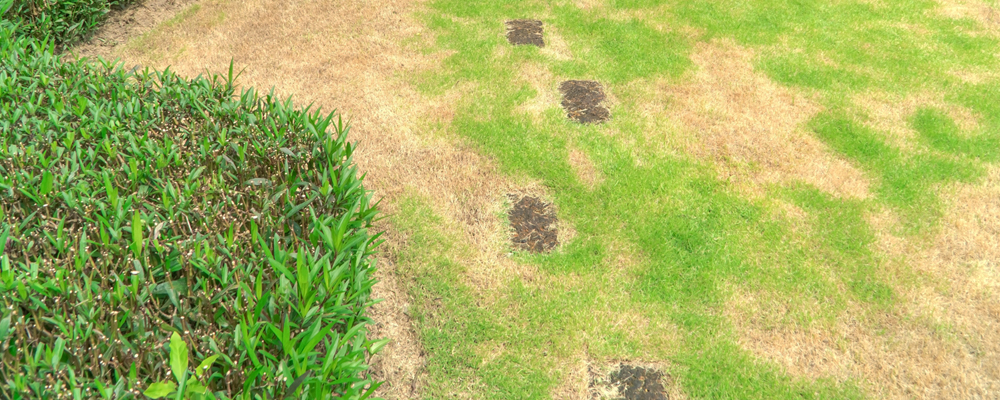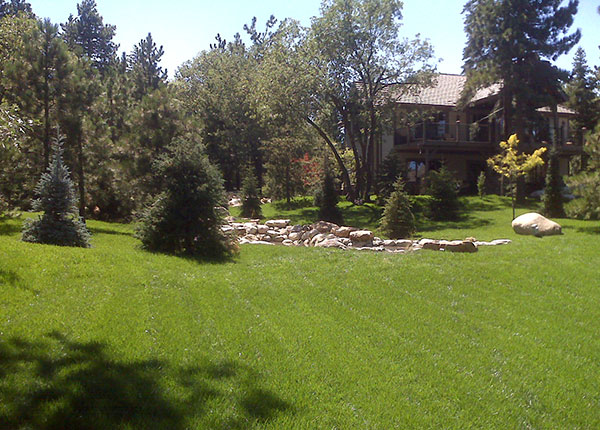Tips for Homeowners
Great advice to keep your lawn looking its best
Best Methods for Repairing Bare Spots in Your Lawn

Spring, Summer and Fall are great times to patch in areas of sod or establish a whole new sod lawn. If you are thinking of a new lawn or patching in some bare areas, these are the times to start working and planning!
Causes for Bare Spots
If you have small areas of dead grass, the first step is to figure out why the grass died in that area. Here are a few possibilities.
- Many times, the problem is an irrigation issue. It is best to have an underground irrigation system since hand-watering or moving sprinklers only works until you go on vacation in July. For underground systems, turn on each irrigation station and do a visual inspection to be sure the sprinklers are not plugged or pointing the wrong direction. If the sprinklers are all working, you may have a problem with uneven distribution or poor head spacing.
- Testing your irrigation system for uniformity is recommended using “catch can test” to make sure your irrigation system is watering all areas of your lawn evenly. Any type of can or container will work well as long as they are all the same size and shape. Tuna cans are ideal because of their wide mouth and shallow depth. Place several empty tuna cans around the irrigation zone, including all dead spots. Then turn on the sprinklers for 15-20 minutes. Measure the amount of water in each tuna can carefully. The water level in each can should be the same. If it isn’t that points to an irrigation issue that needs to be corrected. If the water level in the cans on any dead spots is below that of the rest of the grass, that is most likely the reason for the dead spot in the first place.
- You can get dead grass from traffic patterns of pets or people. To keep your lawn at optimal health, core aerification should be done on the entire lawn on a regular basis. For highly compacted areas, double core aerification of those specific areas is best – every spring and Fall.
- Dead spots in the lawn can be caused by too much shade. Most varieties need 50% sunlight. If grass areas are in shade from your house or trees more than half the day, they will gradually thin out. Some turf varieties tolerate shade better than others, such Ecoloturf (fine fescue) or Elite Plus Fescue. If you can’t get turf shade tolerant varieties to grow, maybe it’s best to place mulch or shade-tolerant perennial plants in these shady spots. Another option would be to have an arborist (a tree professional) assess and possibly reduce the canopy of the tree to allow for more light to reach the lawn. Bare spots can easily be repaired with sod.
Repairing Bare Spots
- Determine the type of grass existing in your lawn. Most lawns in Colorado are bluegrass or tall fescue.
- Prior to laying sod, prepare the soil with a steel-tined garden rake, removing dead grass and opening the soil up to allow water and roots to go down into the soil.
- To plant sod, bring the level of the bare spots ½” below the rest of the lawn because there is some soil with the sod. Cut the sod to fit the bare areas with a serrated knife, cutting on the soil side. Keep moist (but not soggy) for 2-3 weeks until roots are established. Hand-watering works for small areas, especially in the cooler months. If you choose to plant a whole new yard, it is best to use an in-ground irrigation system.
Get A Quote Online
Getting a quote for your sod is easy and convenient. Just let us know how much you need and when you need it. We can even arrange to deliver it right to your work site.

